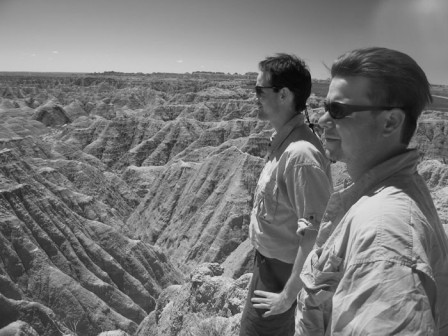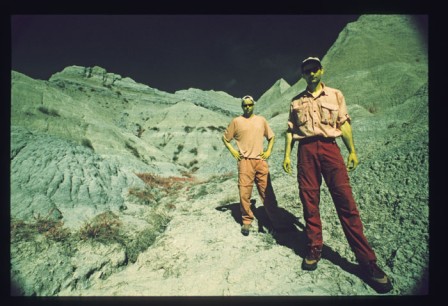I was digging through my files the other day, looking for the seeds of a new blog story, when I came across my first magazine assignment.
I had just sold a major feature to Outpost on an expedition I’d done in the Taklamakan Desert. The story was getting good feedback, and when an opening came they asked me to travel on assignment to South Dakota with photographer Jason George. I was given complete freedom to come up with my story angle, and I worked with our contacts on the ground to arrange the trip.
It seemed funny to me at the time. I was quite poor back then–living in a one-bedroom apartment, working temp jobs during the day and writing late nights at a narrow table in the living room, sitting on the cat’s house. I didn’t even have a proper chair.
I’d spent so many years working shit jobs and saving every penny for travel that I couldn’t believe someone was just going to send me there for free. And what did I have to do in return?
“Tell me a story.”
Are you serious?
Don’t get me wrong—it’s a real job filled with tight deadlines, time pressures, and hard, detailed work. But after so many years of temp drudgery that first magazine assignment felt like an incredible dose of freedom.
That old South Dakota feature isn’t up on the Articles page of my website, so I thought I’d share the first couple pages with you. A bit of a blast from the past, from 2005. Hope ya like it:

To the uninitiated “South Dakota” is prairie-flat and prairie-dull. I expected cowboys and Indians; dude ranches where big city office managers dress up and play Old West. I was apprehensive. I just couldn’t imagine writing a cool story about that.
Standing on the Pinnacles Overlook at Badlands National Park I was forced to rethink my position. Beyond the metal railing the ground dropped away to a convolution of eccentric geology—the bones of the Earth laid bare. The spiny vertebra, the dried up veins and the land’s wrinkled skin were worn open, exposed for all to see on God’s dissection table. Crumbling formations striped with alternating bands of lavender and mud-brown soared into buttes and pillars and plunged into ragged bluffs split by the fissures of dry creeks. From above it’s overwhelming. There’s too much detail; the colours and shapes and the cacophony of crazy angles are too bizarre to process. It doesn’t make sense topographically.
The Sioux called the area ‘mako sica‘—’land bad’. The first white men to bump up against it on their way across the prairies, French fur trappers, called it ‘les mauvaises terres à traverses‘—’the bad land to cross’. It was always an obstacle, a trap, a place you stayed away from.
“Ready?”
“You betcha.”
I threaded rope through my carabiner and kicked off in a clattering crumble of dirt. Caleb Gilkerson of Dakota Adventures followed me down. We’d tied on to the railing of the visitor overlook. Fat RV tourists in Bermuda shorts watched us with incredulity. They couldn’t imagine why anyone would want to go “down there.”
* * *
Millions of years ago, after the vast inland sea receded from the centre of the continent, the Badlands were part of an enormous marshland. Dinosaurs and other beasts wandered the heartland of North America in tropical heat. They died and were gradually covered by sediment. Other creatures came as the centuries wore on, including three-toed horse, a variety of small camel, and saber tooth tiger, and their bones too were entombed for the gratification of present-day fossil hunters.
The marsh eventually dried up and the prairies of the Great Plains emerged. Over the course of about 5 million years streams carved into the soft prairie soil and harsh western winds chiseled the soft rock into fantastic spires, turrets and pinnacles. Today clumps of withered grass on the tops of these buttes and pinnacles serve as a reminder that those distant tops were once part of the smooth alluvial plain. Contrary to popular belief the Badlands, inhospitable and barren as they appear, are not desert but prairie.
The Badlands that we see today are mostly composed of mudstone (the dark bands laid down during dry times) and siltstone (light bands, the product of wetter eras), with the occasional tough sandstone outcropping, all on a base of shale. It’s a surface that’s hard to the touch but it’s easily broken up by water. It’s being cut down at a rate of about 1/2″ per year. Like the sea and the swamps before them, The Badlands too will one day vanish in deep rivers of time—but thankfully not for several million years.

Down on the Badlands floor our boots crunched across a hardpacked flat that looked like frozen mud. Heat waves shimmered from the field-of-Mars landscape. An unbreachable wall towered into a bristling mountain range beyond the flats, and brown-baked Tahitian-island clumps sought sudden elevation in the middle of a frozen mud sea.
Those were my favourite bits of badlands topography. The walking was easier than in the twisting dry gulches. Grim formations menaced overhead with Mordor-gloom. The land held a heavy silence. You could come face to face with a buffalo without ever hearing a warning sound. The visual was even more disorienting than the atmosphere. To walk across such bizarre terrain was to be dwarfed by a sense of total dislocation. There was nothing to give it human perspective or scale. It didn’t relate to anything I’d ever seen before, and so it took me out of myself. We’d been dropped into a sci fi novel, a dimension of the imagination.
We followed animal tracks—mule deer, buffalo, coyote and elusive bobcat. We scanned the ground for fossils and petrified wood. We scrambled up twisted formations just to see what was up there. More often than not we had to run back down, hopping from side to sloping side, laughing uncontrollably at the exhilaration of letting instinct choose our footing. It was too steep and crumbling for a safe slow descent—once begun better to continue, lest a long mudcrumbling slide flay you alive.
Hours later we sat sweat-soaked and dry-throated on the edge of a high plateau that we’d climbed through will of tooth and claw. Behind us the badlands wall plummeted sheer to the swaying green expanse of Buffalo Gap National Grassland. Far to the right a desiccated brown finger poked out into the veldt.
We chose the other view, across the tortured ground we’d covered: canyons and dry gullies, shale falls, mushrooms of scoriascious rock, shadowed cliff side wedges and windswept tops of buttes. As the sun slid across the gunmetal sky the colours and the shapes of the badlands changed. It was a constant transformation from hour to hour. The way out could never look the same as the way in. All sense of perspective was skewed. It’s difficult to get your bearings there, and where your directional bearings are shaken loose your mental bearings, those that shape your life’s orderly direction, are soon to follow.
 (photos © Jason George 2005)
(photos © Jason George 2005)
